Tell us about your project. We will get in touch shortly to discuss in more detail. You can also email us at info@sunstrikestudios.com
Tell us about your project. We will get in touch shortly to discuss in more detail. You can also email us at info@sunstrikestudios.com
Tell us about your project. We will get in touch shortly to discuss in more detail. You can also email us at info@sunstrikestudios.com
The mistakes artists make when creating icons for game items
The mistakes artists make when creating icons for game items
A while back we held a BootCamp for 2d artists. In this article we will share feedback that SunStrike specialists gave on the test works of artists, which they had to perform to get into the BootCamp. We will analyze the main mistakes that artists make when creating icons of game items.
Part 1. Work on geometry
Foreshortening and space filling
In this step, we work with construction, angle selection, and composition in the square (making the object fill the imaginary square).
Let's break down each component separately. First up is the "foreshortening". When choosing a foreshortening, we should show the object in such a way that as many of its details as possible are visible. At the same time, the object should be slightly rotated so that it seems more voluminous and fills as much space as possible in the imaginary square.
What is this "imaginary square" you ask? Icons are made for different purposes. For games, for websites, applications, etc. And there they are not "floating in space". In games, for example, they are often inscribed in a square/circle/oval or other geometric figure.
What mistakes do candidates make at this stage of work?


Let's consider three test cases.
Picture 1. The angle strongly emphasizes the lid of the flask. But the emphasis should rather be on the "belly" of the flask, where the pattern will be depicted. Plus, the imaginary square is poorly filled in here. It leaves a lot of empty space.
Author: Lyubov Kolodeznikova.
Link to portfolio
Picture 2. This is a very nice icon. It is a good view of the object and fills our square, but the emphasis is on the corner of the lid, not on the dial, which is the main part of this object.
Author: Anastasia Efremova.
Picture 3. Here, too, everything is good, but because we see only the front part, we want to turn it a bit either towards us or away from us to see the flat surface of the clock. And if you draw lines down the center of the object, you can see that the clock is symmetrical. Such symmetry is better to avoid in the drawing, because it makes it look unnatural.
Author: Yana Khoruzheva
Let's now try to correct the angle to make the works look more favorable.


Here we tried to show a more suitable angle for these icons.
In the first image the flask now has a better view of the "belly". Now we can show a pattern on it and emphasize the "belly" with lighting. In the second picture we can see the clock face better at the new angle. We can also emphasize it with lighting. In the third picture the clock is turned to show the upper plane. This makes the picture more three-dimensional.
Each part of the picture should work to enhance it. In this case, to make the object more readable. Now let's talk about the size of the parts.
Dimensions of parts
The type of rendering of objects from our examples is not realistic, but also not too stylized. When working out the details, you should not go to extremes, making them too cartoonish or hyperrealistic. Now we will look at some examples where the size of the details was not depicted correctly.
When drawing an icon, it is advisable to always put it next to the references to see if you are going in the right direction. This is what we will do.
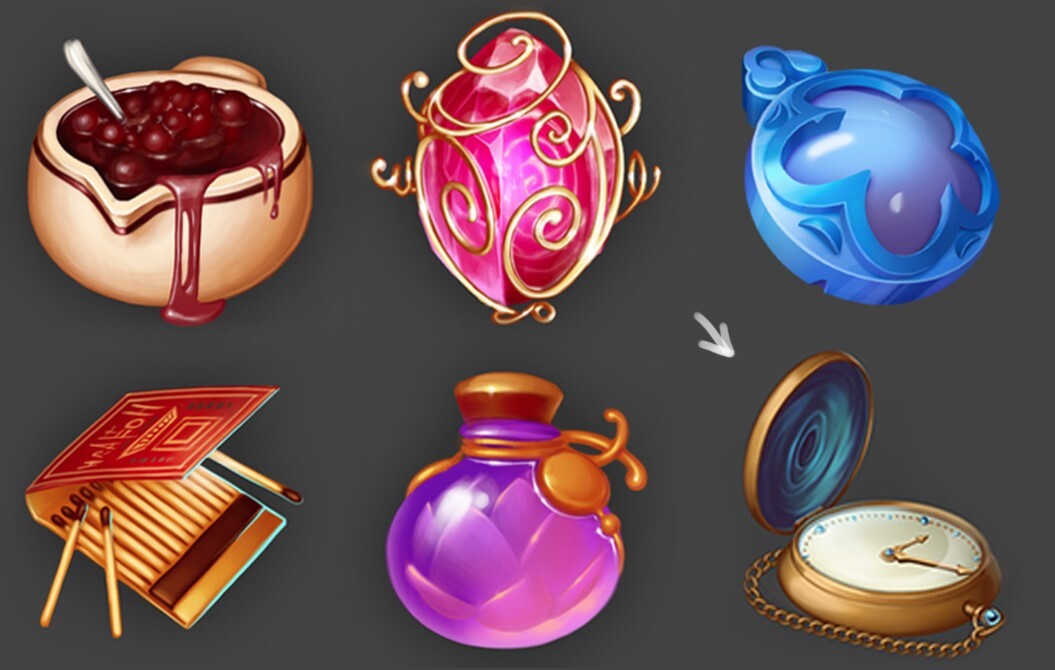

Author: Maria Kuznetsova
Link to portfolio
Let's take the references from our examples and insert the candidate's work instead of one of them (bottom row, right icon). The work turned out to be interesting, but the chain and the dial slightly sags because of their size. How can this be corrected?
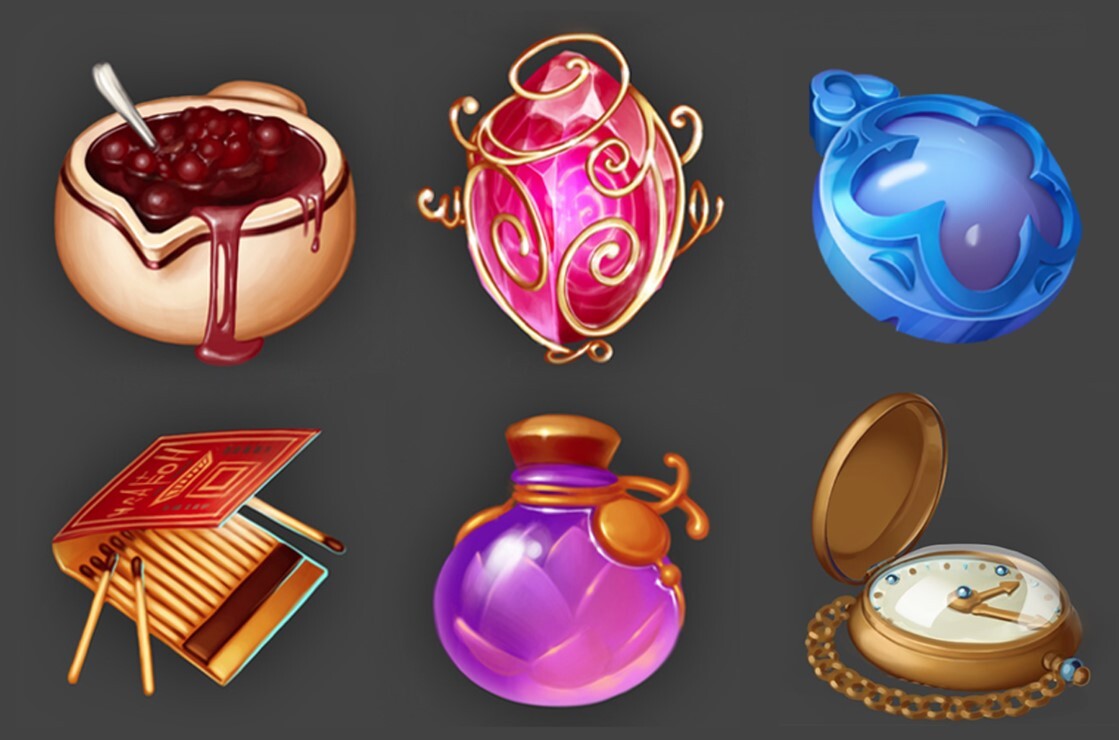

We slightly increased the size of the chain and dial elements. Now the object looks better in terms of detail. Of course, correcting only the detail is not enough. We need to correct the angle and colors as well.
Constructing
Working with the construction is also very important, because due to the divergence of perspective of the elements of the object, the perception of the object is impaired.
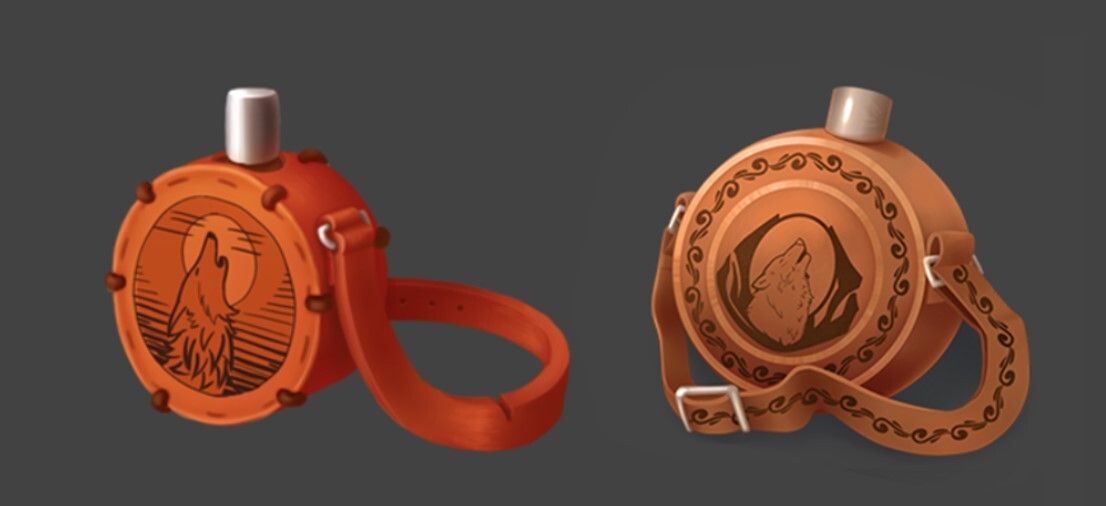
Left: Angelika Efimenko
Right: Irina Mikhailova
In front of you are the works of two candidates. Icons by angle, colors and detailing turned out very cool. But there are problems with geometry construction. Let's look at the first work.
On the left we see the work itself, and on the right:
1. What this object is conventionally supposed to look like.
2. The way he looks now.


Plan of edits:
- Show the direction of the cylinder.
- Draw ellipses.
- Correct the flask.
- Slightly correct the strap (so that the object fits into the square).
We show you the result in the form of a Gif file.

Now let's look at the second job. Here is a similar situation: the cylinders of both the body of the flask and the lid are not quite correctly aligned. Regarding the body, the cylinder turning was not taken into account, so the side could appear unnaturally massive. A slight reversal of the cylinder, like the second icon, would have a reversal like the first example with the 3d picture. We will see a more massive side when the cylinder is rotated more forcefull.

Plan of edits:
- Reducing the sidewall.
- Show the top plane of the lid.
- And taking this opportunity to also try to fit the strap into the square.


Geometry done, now let's move on to color.
Part 2. Color
Let's start with a brief theory. Probably many of you have studied color by sketching from life. Redrawing photos, still lifes, works of masters of painting, carefully looking at colors. Unfortunately, in casual game graphics colors work a little differently than in traditional painting.
For example, let's take an orange ball. In normal lighting, its shadow will remain orange, but will be darker and less saturated. In casual graphics, the same orange ball will use more red colors in the shadow and more yellow colors in the light. That is, to make the color lighter or darker in tone we must also change shades. This creates the colorfulness of the style.


Let's take a look at the candidates' work.
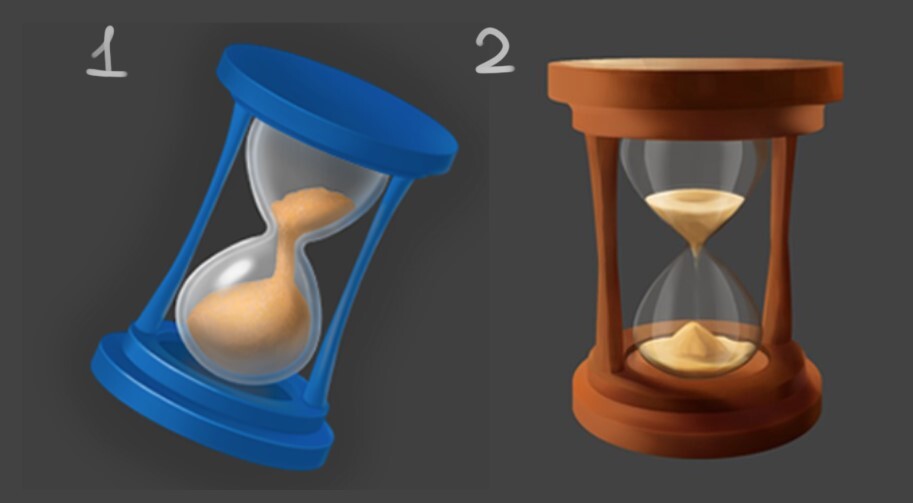

In both the first work and the second, the colors are not quite right.
Let's take the 1st watch.
Author: Daria Kudrina.
The main problem here is that the colors do not render the lighting well. There is no clear separation between light and shadow. In the suggested edits below, we have emphasized the lighted and shadowed parts of the object. To draw light for the blue object, you need to go towards the blue color. And don't be afraid to use saturated colors, so the graphics will become more casual.


Let's do the same for the 2nd watch.
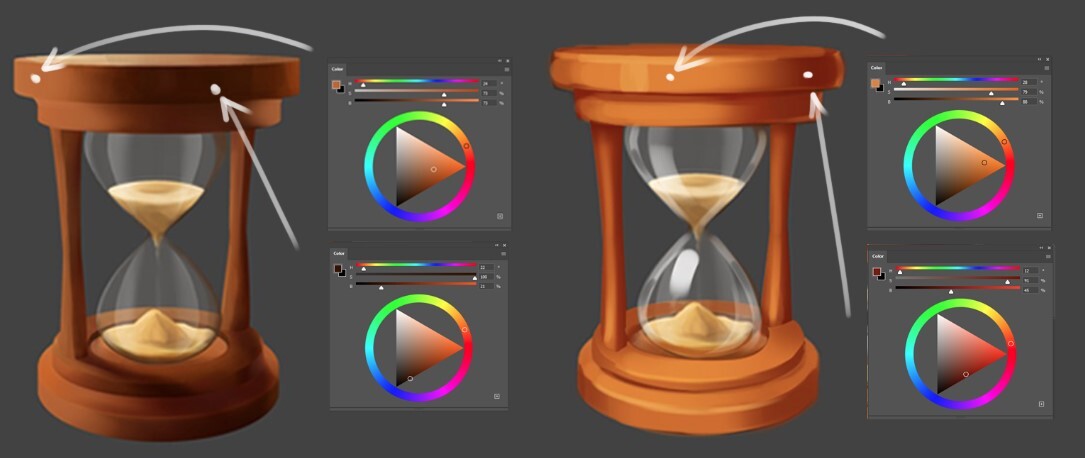

Author: Valentina Piskunova.
In the case of orange, a color closer to yellow for the lighted side and a color closer to red for the shade. Also remember to use saturated colors.
Part 3. Material Render.


No matter what kind of object we draw: a spaceship, a superhero, a monster or a bottle, it all consists of some kind of materials. And if you don't have to pay much attention to materials to work with concepts, then rendering them is crucial for drawing a full-fledged game icon.
Materials come in many forms and to show them, you need to do a little research for yourself. What makes metal metal? What is the visual difference between yellow plasticine and gold? What strokes in a drawing make stone a stone and wood a wood? Once you identify these nuances, you will find it easier to draw materials.
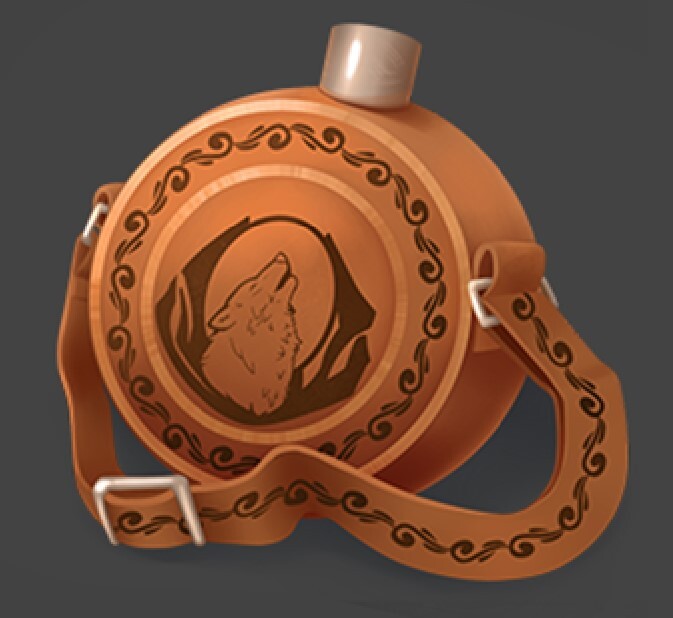
Let's take one of the flasks from the last example and try to improve it, including working on the materials. First of all, let's look at how the flask looks together with the icons on the reference.
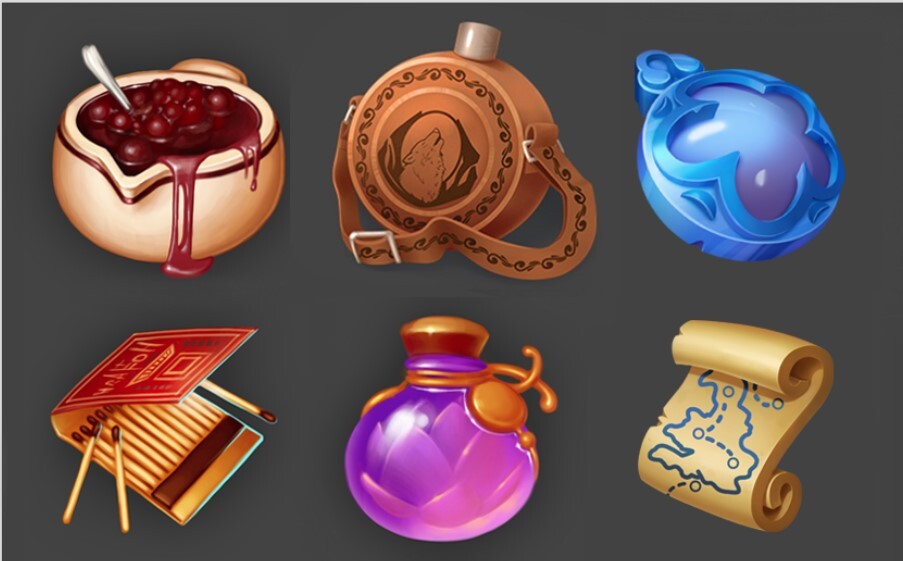

It looks good, but what could be improved:
- Slightly correct the subject's angle and construction to make it look more toward the light, and show the underside and sides of the subject;
- Correct the curve of the strap so that the flask fits better into the square;
- Show the difference in materials between leather and metal more strongly;
- Add a light source at the back to make the shape read better.
Let's get started! In order not to waste time and effort on the construction, we will trick and play with 3D.
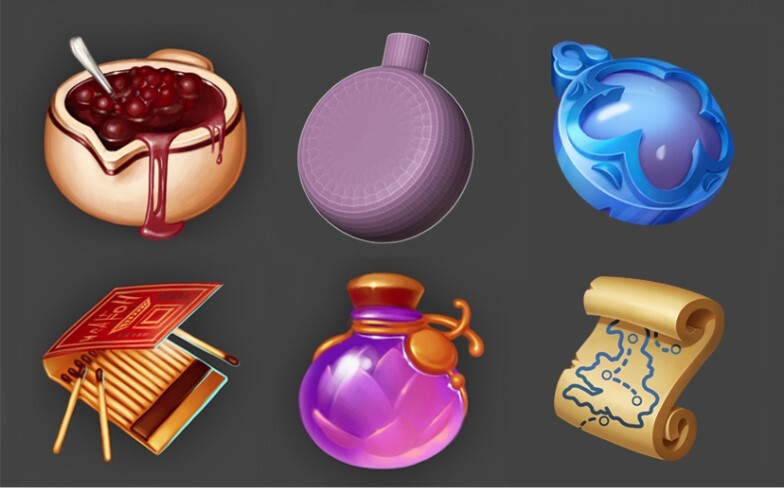

Our curator created a very simple 3d model in Blender, close in proportions to the original icon, and exposed it in the foreshortening. What can be fixed here:
- Slightly tilt the model to the right so that it has the same direction as the map icon;
- Slightly increase the thickness of the lid to stylize it more closely to the references;
- Turn the face slightly toward us.
And this is what we get, leaving room for a future strap.
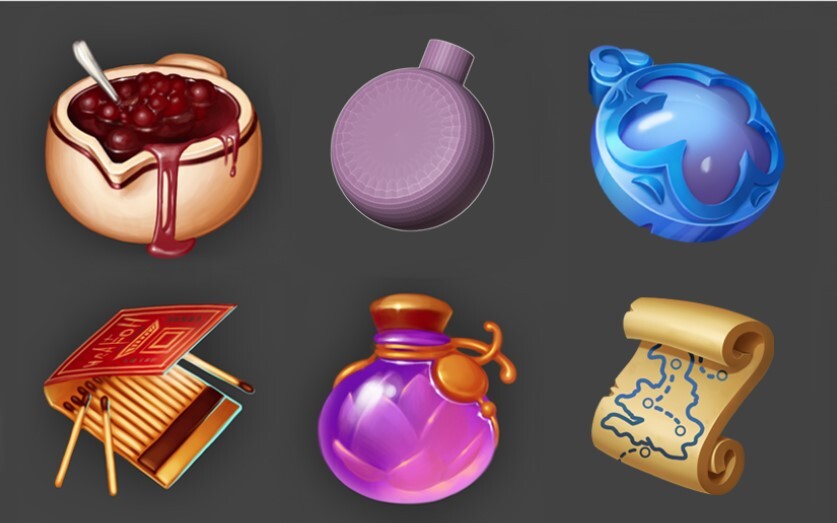

Now, having worked a little with the linework and composition we got such a blank:
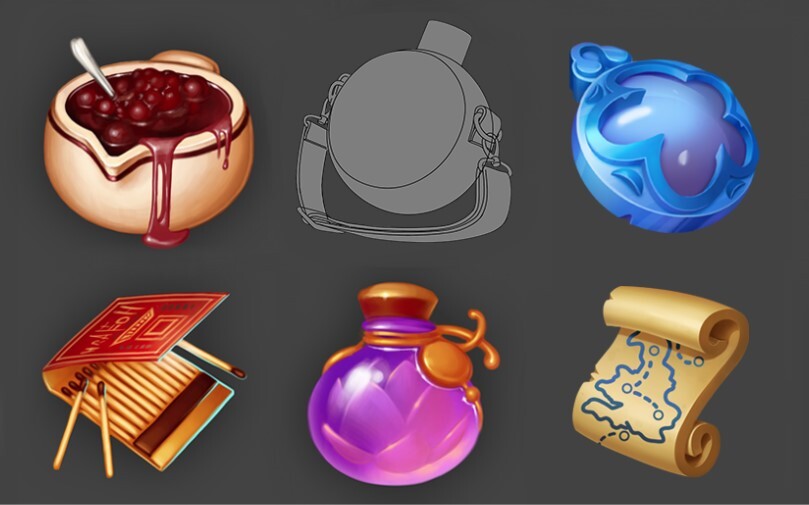

Let's move on to color. Let's try to use the colors from the original icon.


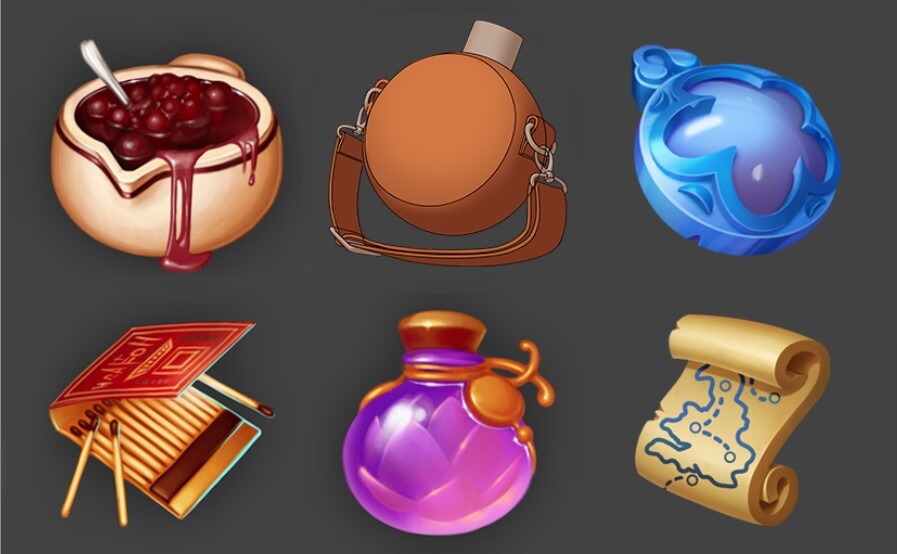

The colors are very good. To make them better, you should work with saturation and brightness. The matte glare can be made even brighter and a bit cooler. The shadow could be made a little redder and more saturated. The metal is now going gray, so you can also make it a little more saturated.
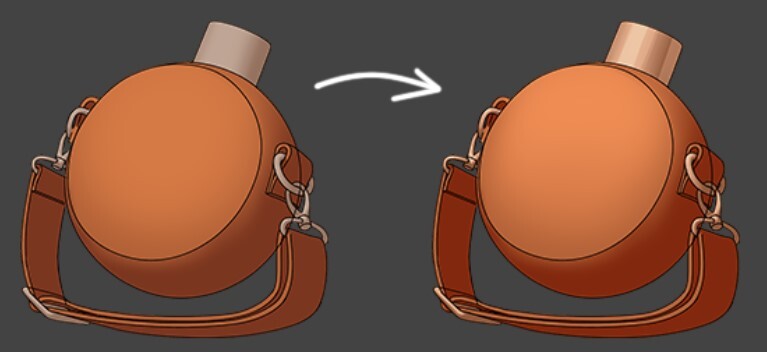

Add occlusion and remove the lane.
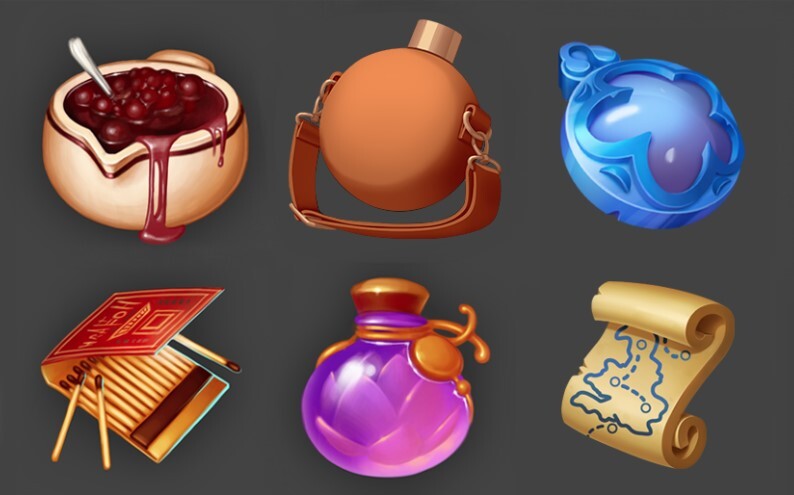

Now it's time to add the wolf image and related details to the skin. We will also slightly correct the strap, as we have an unnatural "straight" angle at the bends.
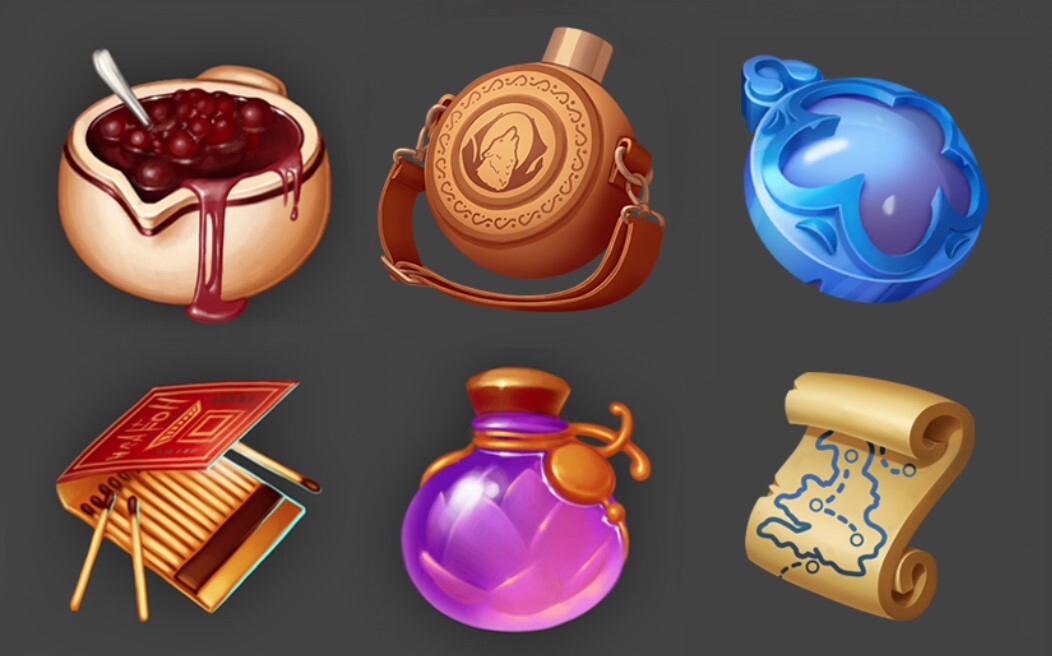

Now we need to refine the texture, add rim light and accent the center part of the work. With the texture will have a little bit of work, because in the center there are a lot of details and their addition can make the picture very noisy. So you have to be careful. Plus, to make the leather material more readable, let's add a seam on the side of the flask.
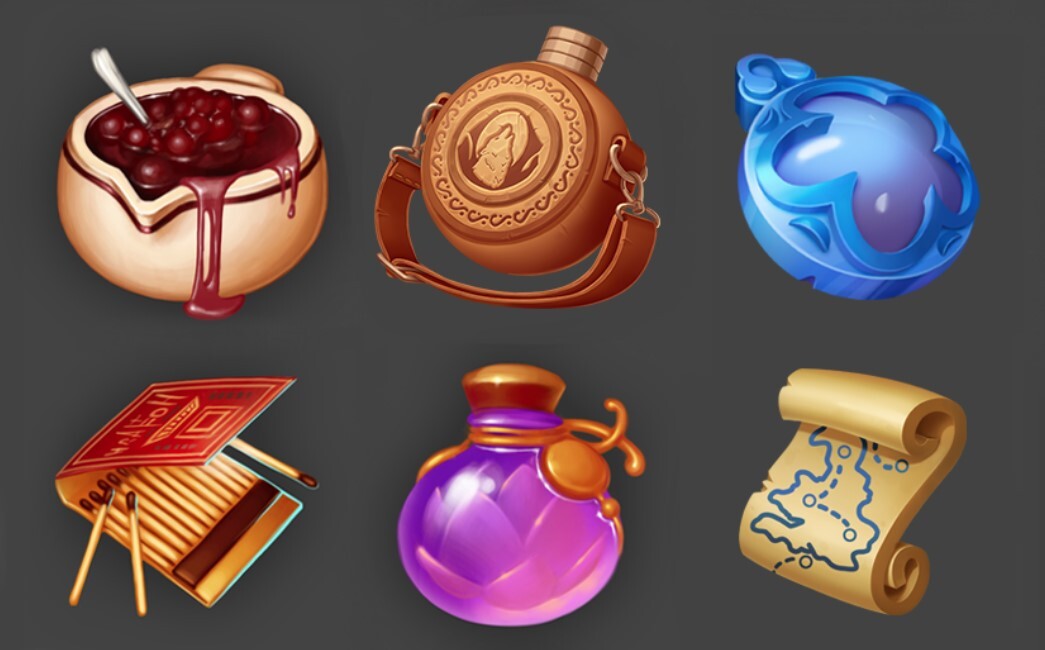

That's all for now. We hope this article will help you to successfully pass the test assignment to our BootCamp next time.
P.S. In the examples, which was given to the BootCamp participants, as an example of icons we took the works from free access by Evgenia Obukhova.
Thank you for your attention!
Email: info@sunstrikestudios.com
Kallipoleos 3, office 102, 1055 Nicosia, Cyprus
Sun Strike Gaming Ltd.
Tell us about your project. We will get in touch shortly to discuss in more detail. You can also email us at info@sunstrikestudios.com
© «SunStrike Studios» 2016-2025
Privacy Policy
Last updated: November 15, 2023
1. Who we are
1.1. We are Sun Strike Gaming Ltd located at Kallipoleos 3, office 102, 1055 Nicosia, Cyprus, working under the brand "Sunstrike Studios".
1.2. This Privacy Policy sets out how we collect and use your personal information when you use the mobile, online and downloadable products and services ("Services") offered by Sun Strike Gaming Ltd and its subsidiaries at https://sunstrikestudios.com/ and the choices available to you in connection with our use of your personal information (the Privacy Policy).This Privacy Policy should be read alongside, and in addition to, our terms and conditions at https://sunstrikestudios.com/ (Terms). In case of any contradictions between this Privacy Policy and the Terms, this Privacy Policy will prevail.
2. This Privacy Policy
2.1. By making available the Services we, acting reasonably and in good faith, believe that you:(a) have all necessary rights to register on and use the Services;(b) provide true information about yourself to the extent necessary for use of the Services;(c) understand that by the posting your personal information you have manifestly made this information public, and this information may become available to other Site users and internet users, be copied and disseminated by them;(d) understand that some types of information transferred by you to other Service users cannot be deleted by you or us;(e) are aware of and accept this Privacy Policy.
2.2. We do not check the user information received from you, except where such check is necessary in order for us to fulfill our obligations to you.
2.3. This Privacy Policy applies only to the European Union-based users. If you are not a European Union-based user, please refer to the Privacy Policy applicable in the relevant jurisdiction.
3. Information we collect about you
3.1. In order to implement the agreement between you and us, and provide you with access to the use of the Services, we will improve, develop and implement new features to our Services, and enhance the available Services functionality. To achieve these objectives, and in compliance with applicable laws, we will collect, store, aggregate, organise, extract, compare, use, and supplement your data (hereinafter “processing”). We will also receive and pass this data, and our automatically processed analyses of this data to our affiliates and partners as set out in the table below and section 4 of this Privacy Policy.
3.2. We set out in more detail the information we collect when you use our Services, why we collect and process it and the legal bases below.
# | Information Collected | Purpose | Legal Basis |
|---|---|---|---|
1 | Data you provide for registering in the Services including your email and/or mobile phone number | We use this information in order to manage and administer the Services provided to you. We use this data to enable us to fulfill our obligations to you as part of the Services (e.g. in cases where you request restoration of your account). See section 8.3 of this Privacy Policy for more information. We also use this information in order to provide you with updates and information on our and selected third parties' products and services we think you may be interested in. | Legitimate interests Performance of our contract with you |
2 | Where necessary, a copy of your identity or another document containing your name, surname, photograph, number of the principal identity document of you or your representative, payment details and another additional data, with that you may provide us, including through our support service.We may take additional verification steps where we consider reasonable in order to verify your account. | We use this data in order to identify you, verify your account and prevent abuse and infringements of your or other persons' rights.For example, we use this information to verify your identity if you lose your credentials and wish to access your account with us. | Legitimate Interests |
3 | Additional data you provide on dedicated Services profile page via including your first and last name, nickname, gender, date of birth, avatar picture and language preferences. | We use this information in order to provide our Services to you, to manage and administer Services and as additional information to verify your account to prevent abuse and infringements of your or other persons' rights. We also use this information in order to provide you with updates and information on our and selected third parties' products and services we think you may be interested in.We use this information in order to tailor and improve the adverts that are presented on the Site and measure the effectiveness of these advertisements. | Legitimate interests Performance of our contract with you |
4 | Additional data received when you access the Services, including information regarding technical devices, technical interaction with the Service such as your IP-address, time of registration in the Service, device ids, country and language settings, device model and operating system used, your installed apps, type of browser, your Internet provider and/or phone network operator, network type, screen resolution, RAM size and your browsing behavior. | We use your data for internal review in order to constantly improve the content of our Services and web pages, optimizing your user experience, to understand any errors you may encounter when using the Services, to notify you of changes to the Services and to personalise the use of our Services.We use this information in order to tailor and improve the adverts that are presented on the Site and measure the effectiveness of these advertisements. | Legitimate Interests |
5 | Information that is automatically received at the time of access to the Services with the use of cookies. | Please see our cookies policy which sets out the types of cookies we use and what we use these cookies for. We use this information in order to tailor and improve the adverts that are presented on the Site and measure the effectiveness of these advertisements. | Consent |
6 | Information that is created by you while using the Services (including information that you post in any game forums and/or chat rooms). Depending on the place of posting (chat room or forum) this information can be available to some or all other users of our Services. | We use this information in order to manage and administer the Services including providing our services to you. | Legitimate interests, which inter alia, include the processing of manifestly made public by you data Performance of our contract with you |
7 | Information that is created by you while placing requests to our Services support. | We use this information in order to verify your identity and to fulfil your support request. We may also use this data in order to investigate any complaints on your behalf and to provide you with a more efficient service. | Legitimate interests Performance of our contract with you |
8 | Information that is received as the result of your behavioral actions when using the Services (including your game actions and achievements, badges). This information can be available to other users of our Services (e.g. on Leaderboards). | We use this information in order to manage and administer the Services including providing our Services to you. We may also use this data in order to tailor and improve the adverts that are presented to you to and measure the effectiveness of these advertisements. | Legitimate interests |
9 | Information that is received about you as the result of other users’ actions on the Services (in particular, information posted in chat rooms and forums by other users). | We use this information in order to manage and administer the Services including providing our Services to you. | Legitimate interests |
10 | Data collected via third parties, including your social network ids, application store ids, nickname, email and friends list, when you register in our Services via you social or application store accounts and/or connect your social account to our Services. | We use this information in order to manage and administer the Services provided to you. We use this information for certain social functions of our Services, such as to show you who of your friends play the same game as you. We also use this information in order to provide you with updates and information on our and selected third parties' products and services we think you may be interested in. | Legitimate interests Performance of our contract with you |
3.3. Our legitimate interests include (1) maintaining and administrating the Services; (2) providing the Services to you; (3) improving the content of the Services and web pages; (4) processing of the data that was manifestly made public by you; (5) ensuring your account is adequately protected; and (6) compliance with any contractual, legal or regulatory obligations under any applicable law.
3.4. As part of maintaining and administrating the Services we use the information to analyse user activity and ensure that rules and terms of use for the Services are not violated.
3.5. Your personal information may also be processed if it is required by a law enforcement or regulatory authority, body or agency or in the defence or exercise of legal claims.We will not delete personal information if it is relevant to an investigation or a dispute.It will continue to be stored until those issues are fully resolved and/or during the term that is required and/or permissible under applicable/relevant law.
3.6. You may withdraw your consent to sending you marketing information by amending your privacy settings of your account.
3.7. Please note, if you do not want us to process sensitive and special categories of data about you (including data relating to your health, racial or ethnic origin, political opinion, religious or philosophical beliefs, sex life, and your sexual orientation) you should take care not to post this information or share this data on the Site.Once you have provided this data it will be accessible by other site users and it becomes difficult for us to remove this data.
3.8. Please note, if you withdraw your consent to processing or you do not provide the data that we require in order to maintain and administer the Services, you may not be able to access the Services or register with the web pages.
3.9. If we intend to further process your data for any other purpose to those set out in this Privacy Policy, we shall provide you with details of this further purpose before we commence processing.
4. Data sharing
4.1. Your username can be available to all of the Service users. We take technical and organizational measures to ensure that your data is safe. Please note that by the posting your personal information you have manifestly made this information public, and this may become available to other Service users and internet users and be copied and/ or disseminated by such users. Once this data is transferred by you to other users you will not be able to delete this data.
4.2. Sometimes we may need to share your data with a third party in order to provide our Services to you or to administer the Services, for example if you choose to share your data across other social media platforms.
4.3. We may also share your data with our third party contractors and application developers provided these third parties assume confidentiality obligations regarding your personal data collected by your use of the applications they offer. The developers use the information provided to them in order to provide you with additional services. Data will only be shared with these developers with your consent. You can authorise developers to access your information via our products.
4.4. Our ad management and recommendation system is designed so that your information will not be shared directly with our third party advertisers. An advertiser or maker of a recommendation can only choose to target advertisements to groups of users falling within criteria such as age, gender or location, or to target communities according to type, e.g. cars or fashion. If you fall within one of the target groups you will receive an advert or recommendation.
4.5. An advertiser or maker of recommendations may also choose to upload a list of emails, phone numbers and identities to our systems so that we (but not the adviser or maker of recommendations) can check for user matches. They will see the number of matches but not the matches themselves.
4.6. If you participate in public tournaments we may have the obligation to disclose your personal information to tax authorities. We also may publish your data as part of the tournament score tables on our and third party websites.
4.7. Sun Strike Gaming Ltd or our selected third party partners with our permission, using their own ad servers, can show advertisements to you.
5. Privacy Settings
5.1. The Services may contain links to sites operated by third parties. We are not responsible for your data privacy when you access these links or engage with third party services and you should ensure you review the relevant third party's privacy statement which will govern your data privacy rights.
5.2. We bear no liability for the actions of third parties which, as the result of your use of the internet or the Services, obtain access to your information in accordance with the confidentiality level selected by you.
5.3. We bear no liability for the consequences of use of the information which, due to the Services nature, is available to any internet user. We ask you to take a responsible approach to the scope of their information posted on the Site.
6. International Transfers
6.1. We may transfer and maintain on our servers or databases some of your personal information outside the European Economic Area (EEA) including in Russia.
6.2. The countries to which we transfer your data may not have the same data protection laws as your jurisdiction. We take reasonable cyber security measures and/or put in place the Standard Contractual Clauses (e.g. Model Clauses, Data Processing Agreement/Addendum) to ensure your data is adequately protected.
7. Retention Periods
7.1. We will retain your personal information for as long as required to perform the purposes for which the data was collected depending on the legal basis for which that data was obtained and/or whether additional legal/regulatory obligations mandate that we retain your personal information during the term that is required and/or permissible under applicable/relevant law.
7.2. You may delete your personal data by removing the data from your account; alternatively, you can delete your account.
7.3. We may remove your account, or the information you post as provided by the Terms.
8. Your Rights
8.1. You have the following rights, in certain circumstances, in relation to your personal information:(a) Right to access your personal information.(b) Right to rectify your personal information: you can request that we update, block or delete your personal data, if the data is incomplete, outdated, incorrect, unlawfully received or no longer relevant for the purpose of processing.(c) Right to restrict the use of your personal information.(d) Right to request that your personal information is erased.(e) Right to object to processing of your personal information.(f) Right to data portability (in certain specific circumstances).(g) Right not to be subject to an automated decision.(h) Right to lodge a complaint with a supervisory authority.
8.2. You also have a right to independently remove personal information on your account and make changes and corrections to your information, provided that such changes and corrections contain up-to-date and true information. You can also view an overview of the information we hold about you.
8.3. If you would like to exercise these rights, please contact Support Service at support@sunstrikestudios.com or send your request to us, in writing to Kallipoleos 3, office 102, 1055 Nicosia, Cyprus. We will aim to respond to you within 30 days from receipt of request. We will need to verify your identity before we are able to disclose any personal data to you.
9. Security Measures
9.1. We take technical, organizational and legal measures, including, where suitable, encryption, to ensure that your personal data are protected from unauthorized or accidental access, deletion, modification, blocking, copying and dissemination.
9.2. Access to the Services is authorized using your login (e-mail address or mobile phone number) and password. You are responsible for keeping this information confidential. You should not share your credentials with third parties and we recommend you take measures to ensure this information is kept confidential.
9.3. If you forget your login details, you can request us to send you an SMS or email, which will contain a restoration code.
9.4. To reduce the probability of third parties gaining unauthorized access, if you login to your account from an unusual place or after several failed attempts to provide valid login details, we may block entry to your account. You will then need to contact Service support and provide certain additional information to verify your credentials and gain access to your account.
10. Changes to this Policy
10.1. From time to time, we may change and/or update this Privacy Policy. If this Privacy Policy changes in any way, we will post an updated version on this page. We will store the previous versions of this Privacy Policy in our documentation achieve. We recommend you regularly review this page to ensure that you are always aware of our information practices and any changes to such.
11. Contact Us
11.1. If you have any questions, please send your inquiries to Service support at support@sunstrikestudios.com or send your request to us, in writing to Kallipoleos 3, office 102, 1055 Nicosia, Cyprus. So we can deal with your enquiry effectively, please quote this Privacy Policy. We will aim to respond to you within 30 days from receipt of request.
11.2. All correspondence received by us from you (written or electronic inquiries) is classified as restricted-access information and may not be disclosed without your written consent. The personal data and other information about you may not be used without your consent for any purpose other than for response to the inquiry, except as expressly provided by law.
© Sun Strike Gaming Ltd . 2023
Email: info@sunstrikestudios.com
Kallipoleos 3, office 102, 1055 Nicosia, Cyprus
Sun Strike Gaming Ltd.
Tell us about your project. We will get in touch shortly to discuss in more detail. You can also email us at info@sunstrikestudios.com
«SunStrike Studios» © 2016-2025
Privacy Policy
Last updated: November 15, 2023
1. Who we are
1.1. We are Sun Strike Gaming Ltd located at Kallipoleos 3, office 102, 1055 Nicosia, Cyprus, working under the brand "Sunstrike Studios".
1.2. This Privacy Policy sets out how we collect and use your personal information when you use the mobile, online and downloadable products and services ("Services") offered by Sun Strike Gaming Ltd and its subsidiaries at https://sunstrikestudios.com/ and the choices available to you in connection with our use of your personal information (the Privacy Policy).This Privacy Policy should be read alongside, and in addition to, our terms and conditions at https://sunstrikestudios.com/ (Terms). In case of any contradictions between this Privacy Policy and the Terms, this Privacy Policy will prevail.
2. This Privacy Policy
2.1. By making available the Services we, acting reasonably and in good faith, believe that you:(a) have all necessary rights to register on and use the Services;(b) provide true information about yourself to the extent necessary for use of the Services;(c) understand that by the posting your personal information you have manifestly made this information public, and this information may become available to other Site users and internet users, be copied and disseminated by them;(d) understand that some types of information transferred by you to other Service users cannot be deleted by you or us;(e) are aware of and accept this Privacy Policy.
2.2. We do not check the user information received from you, except where such check is necessary in order for us to fulfill our obligations to you.
2.3. This Privacy Policy applies only to the European Union-based users. If you are not a European Union-based user, please refer to the Privacy Policy applicable in the relevant jurisdiction.
3. Information we collect about you
3.1. In order to implement the agreement between you and us, and provide you with access to the use of the Services, we will improve, develop and implement new features to our Services, and enhance the available Services functionality. To achieve these objectives, and in compliance with applicable laws, we will collect, store, aggregate, organise, extract, compare, use, and supplement your data (hereinafter “processing”). We will also receive and pass this data, and our automatically processed analyses of this data to our affiliates and partners as set out in the table below and section 4 of this Privacy Policy.
3.2. We set out in more detail the information we collect when you use our Services, why we collect and process it and the legal bases below.
# | Information Collected | Purpose | Legal Basis |
|---|---|---|---|
1 | Data you provide for registering in the Services including your email and/or mobile phone number | We use this information in order to manage and administer the Services provided to you. We use this data to enable us to fulfill our obligations to you as part of the Services (e.g. in cases where you request restoration of your account). See section 8.3 of this Privacy Policy for more information. We also use this information in order to provide you with updates and information on our and selected third parties' products and services we think you may be interested in. | Legitimate interests Performance of our contract with you |
2 | Where necessary, a copy of your identity or another document containing your name, surname, photograph, number of the principal identity document of you or your representative, payment details and another additional data, with that you may provide us, including through our support service.We may take additional verification steps where we consider reasonable in order to verify your account. | We use this data in order to identify you, verify your account and prevent abuse and infringements of your or other persons' rights.For example, we use this information to verify your identity if you lose your credentials and wish to access your account with us. | Legitimate Interests |
3 | Additional data you provide on dedicated Services profile page via including your first and last name, nickname, gender, date of birth, avatar picture and language preferences. | We use this information in order to provide our Services to you, to manage and administer Services and as additional information to verify your account to prevent abuse and infringements of your or other persons' rights. We also use this information in order to provide you with updates and information on our and selected third parties' products and services we think you may be interested in.We use this information in order to tailor and improve the adverts that are presented on the Site and measure the effectiveness of these advertisements. | Legitimate interests Performance of our contract with you |
4 | Additional data received when you access the Services, including information regarding technical devices, technical interaction with the Service such as your IP-address, time of registration in the Service, device ids, country and language settings, device model and operating system used, your installed apps, type of browser, your Internet provider and/or phone network operator, network type, screen resolution, RAM size and your browsing behavior. | We use your data for internal review in order to constantly improve the content of our Services and web pages, optimizing your user experience, to understand any errors you may encounter when using the Services, to notify you of changes to the Services and to personalise the use of our Services.We use this information in order to tailor and improve the adverts that are presented on the Site and measure the effectiveness of these advertisements. | Legitimate Interests |
5 | Information that is automatically received at the time of access to the Services with the use of cookies. | Please see our cookies policy which sets out the types of cookies we use and what we use these cookies for. We use this information in order to tailor and improve the adverts that are presented on the Site and measure the effectiveness of these advertisements. | Consent |
6 | Information that is created by you while using the Services (including information that you post in any game forums and/or chat rooms). Depending on the place of posting (chat room or forum) this information can be available to some or all other users of our Services. | We use this information in order to manage and administer the Services including providing our services to you. | Legitimate interests, which inter alia, include the processing of manifestly made public by you data Performance of our contract with you |
7 | Information that is created by you while placing requests to our Services support. | We use this information in order to verify your identity and to fulfil your support request. We may also use this data in order to investigate any complaints on your behalf and to provide you with a more efficient service. | Legitimate interests Performance of our contract with you |
8 | Information that is received as the result of your behavioral actions when using the Services (including your game actions and achievements, badges). This information can be available to other users of our Services (e.g. on Leaderboards). | We use this information in order to manage and administer the Services including providing our Services to you. We may also use this data in order to tailor and improve the adverts that are presented to you to and measure the effectiveness of these advertisements. | Legitimate interests |
9 | Information that is received about you as the result of other users’ actions on the Services (in particular, information posted in chat rooms and forums by other users). | We use this information in order to manage and administer the Services including providing our Services to you. | Legitimate interests |
10 | Data collected via third parties, including your social network ids, application store ids, nickname, email and friends list, when you register in our Services via you social or application store accounts and/or connect your social account to our Services. | We use this information in order to manage and administer the Services provided to you. We use this information for certain social functions of our Services, such as to show you who of your friends play the same game as you. We also use this information in order to provide you with updates and information on our and selected third parties' products and services we think you may be interested in. | Legitimate interests Performance of our contract with you |
3.3. Our legitimate interests include (1) maintaining and administrating the Services; (2) providing the Services to you; (3) improving the content of the Services and web pages; (4) processing of the data that was manifestly made public by you; (5) ensuring your account is adequately protected; and (6) compliance with any contractual, legal or regulatory obligations under any applicable law.
3.4. As part of maintaining and administrating the Services we use the information to analyse user activity and ensure that rules and terms of use for the Services are not violated.
3.5. Your personal information may also be processed if it is required by a law enforcement or regulatory authority, body or agency or in the defence or exercise of legal claims.We will not delete personal information if it is relevant to an investigation or a dispute.It will continue to be stored until those issues are fully resolved and/or during the term that is required and/or permissible under applicable/relevant law.
3.6. You may withdraw your consent to sending you marketing information by amending your privacy settings of your account.
3.7. Please note, if you do not want us to process sensitive and special categories of data about you (including data relating to your health, racial or ethnic origin, political opinion, religious or philosophical beliefs, sex life, and your sexual orientation) you should take care not to post this information or share this data on the Site.Once you have provided this data it will be accessible by other site users and it becomes difficult for us to remove this data.
3.8. Please note, if you withdraw your consent to processing or you do not provide the data that we require in order to maintain and administer the Services, you may not be able to access the Services or register with the web pages.
3.9. If we intend to further process your data for any other purpose to those set out in this Privacy Policy, we shall provide you with details of this further purpose before we commence processing.
4. Data sharing
4.1. Your username can be available to all of the Service users. We take technical and organizational measures to ensure that your data is safe. Please note that by the posting your personal information you have manifestly made this information public, and this may become available to other Service users and internet users and be copied and/ or disseminated by such users. Once this data is transferred by you to other users you will not be able to delete this data.
4.2. Sometimes we may need to share your data with a third party in order to provide our Services to you or to administer the Services, for example if you choose to share your data across other social media platforms.
4.3. We may also share your data with our third party contractors and application developers provided these third parties assume confidentiality obligations regarding your personal data collected by your use of the applications they offer. The developers use the information provided to them in order to provide you with additional services. Data will only be shared with these developers with your consent. You can authorise developers to access your information via our products.
4.4. Our ad management and recommendation system is designed so that your information will not be shared directly with our third party advertisers. An advertiser or maker of a recommendation can only choose to target advertisements to groups of users falling within criteria such as age, gender or location, or to target communities according to type, e.g. cars or fashion. If you fall within one of the target groups you will receive an advert or recommendation.
4.5. An advertiser or maker of recommendations may also choose to upload a list of emails, phone numbers and identities to our systems so that we (but not the adviser or maker of recommendations) can check for user matches. They will see the number of matches but not the matches themselves.
4.6. If you participate in public tournaments we may have the obligation to disclose your personal information to tax authorities. We also may publish your data as part of the tournament score tables on our and third party websites.
4.7. Sun Strike Gaming Ltd or our selected third party partners with our permission, using their own ad servers, can show advertisements to you.
5. Privacy Settings
5.1. The Services may contain links to sites operated by third parties. We are not responsible for your data privacy when you access these links or engage with third party services and you should ensure you review the relevant third party's privacy statement which will govern your data privacy rights.
5.2. We bear no liability for the actions of third parties which, as the result of your use of the internet or the Services, obtain access to your information in accordance with the confidentiality level selected by you.
5.3. We bear no liability for the consequences of use of the information which, due to the Services nature, is available to any internet user. We ask you to take a responsible approach to the scope of their information posted on the Site.
6. International Transfers
6.1. We may transfer and maintain on our servers or databases some of your personal information outside the European Economic Area (EEA) including in Russia.
6.2. The countries to which we transfer your data may not have the same data protection laws as your jurisdiction. We take reasonable cyber security measures and/or put in place the Standard Contractual Clauses (e.g. Model Clauses, Data Processing Agreement/Addendum) to ensure your data is adequately protected.
7. Retention Periods
7.1. We will retain your personal information for as long as required to perform the purposes for which the data was collected depending on the legal basis for which that data was obtained and/or whether additional legal/regulatory obligations mandate that we retain your personal information during the term that is required and/or permissible under applicable/relevant law.
7.2. You may delete your personal data by removing the data from your account; alternatively, you can delete your account.
7.3. We may remove your account, or the information you post as provided by the Terms.
8. Your Rights
8.1. You have the following rights, in certain circumstances, in relation to your personal information:(a) Right to access your personal information.(b) Right to rectify your personal information: you can request that we update, block or delete your personal data, if the data is incomplete, outdated, incorrect, unlawfully received or no longer relevant for the purpose of processing.(c) Right to restrict the use of your personal information.(d) Right to request that your personal information is erased.(e) Right to object to processing of your personal information.(f) Right to data portability (in certain specific circumstances).(g) Right not to be subject to an automated decision.(h) Right to lodge a complaint with a supervisory authority.
8.2. You also have a right to independently remove personal information on your account and make changes and corrections to your information, provided that such changes and corrections contain up-to-date and true information. You can also view an overview of the information we hold about you.
8.3. If you would like to exercise these rights, please contact Support Service at support@sunstrikestudios.com or send your request to us, in writing to Kallipoleos 3, office 102, 1055 Nicosia, Cyprus. We will aim to respond to you within 30 days from receipt of request. We will need to verify your identity before we are able to disclose any personal data to you.
9. Security Measures
9.1. We take technical, organizational and legal measures, including, where suitable, encryption, to ensure that your personal data are protected from unauthorized or accidental access, deletion, modification, blocking, copying and dissemination.
9.2. Access to the Services is authorized using your login (e-mail address or mobile phone number) and password. You are responsible for keeping this information confidential. You should not share your credentials with third parties and we recommend you take measures to ensure this information is kept confidential.
9.3. If you forget your login details, you can request us to send you an SMS or email, which will contain a restoration code.
9.4. To reduce the probability of third parties gaining unauthorized access, if you login to your account from an unusual place or after several failed attempts to provide valid login details, we may block entry to your account. You will then need to contact Service support and provide certain additional information to verify your credentials and gain access to your account.
10. Changes to this Policy
10.1. From time to time, we may change and/or update this Privacy Policy. If this Privacy Policy changes in any way, we will post an updated version on this page. We will store the previous versions of this Privacy Policy in our documentation achieve. We recommend you regularly review this page to ensure that you are always aware of our information practices and any changes to such.
11. Contact Us
11.1. If you have any questions, please send your inquiries to Service support at support@sunstrikestudios.com or send your request to us, in writing to Kallipoleos 3, office 102, 1055 Nicosia, Cyprus. So we can deal with your enquiry effectively, please quote this Privacy Policy. We will aim to respond to you within 30 days from receipt of request.
11.2. All correspondence received by us from you (written or electronic inquiries) is classified as restricted-access information and may not be disclosed without your written consent. The personal data and other information about you may not be used without your consent for any purpose other than for response to the inquiry, except as expressly provided by law.
© Sun Strike Gaming Ltd. 2023
Email: info@sunstrikestudios.com
Kallipoleos 3, office 102, 1055 Nicosia, Cyprus
Sun Strike Gaming Ltd.
Tell us about your project. We will get in touch shortly to discuss in more detail. You can also email us at info@sunstrikestudios.com
© «SunStrike Studios» 2016-2025
Privacy Policy
Last updated: November 15, 2023
1. Who we are
1.1. We are Sun Strike Gaming Ltd located at Kallipoleos 3, office 102, 1055 Nicosia, Cyprus, working under the brand "Sunstrike Studios".
1.2. This Privacy Policy sets out how we collect and use your personal information when you use the mobile, online and downloadable products and services ("Services") offered by Sun Strike Gaming Ltd and its subsidiaries at https://sunstrikestudios.com/ and the choices available to you in connection with our use of your personal information (the Privacy Policy).This Privacy Policy should be read alongside, and in addition to, our terms and conditions at https://sunstrikestudios.com/ (Terms). In case of any contradictions between this Privacy Policy and the Terms, this Privacy Policy will prevail.
2. This Privacy Policy
2.1. By making available the Services we, acting reasonably and in good faith, believe that you:(a) have all necessary rights to register on and use the Services;(b) provide true information about yourself to the extent necessary for use of the Services;(c) understand that by the posting your personal information you have manifestly made this information public, and this information may become available to other Site users and internet users, be copied and disseminated by them;(d) understand that some types of information transferred by you to other Service users cannot be deleted by you or us;(e) are aware of and accept this Privacy Policy.
2.2. We do not check the user information received from you, except where such check is necessary in order for us to fulfill our obligations to you.
2.3. This Privacy Policy applies only to the European Union-based users. If you are not a European Union-based user, please refer to the Privacy Policy applicable in the relevant jurisdiction.
3. Information we collect about you
3.1. In order to implement the agreement between you and us, and provide you with access to the use of the Services, we will improve, develop and implement new features to our Services, and enhance the available Services functionality. To achieve these objectives, and in compliance with applicable laws, we will collect, store, aggregate, organise, extract, compare, use, and supplement your data (hereinafter “processing”). We will also receive and pass this data, and our automatically processed analyses of this data to our affiliates and partners as set out in the table below and section 4 of this Privacy Policy.
3.2. We set out in more detail the information we collect when you use our Services, why we collect and process it and the legal bases below.
# | Information Collected | Purpose | Legal Basis |
|---|---|---|---|
1 | Data you provide for registering in the Services including your email and/or mobile phone number | We use this information in order to manage and administer the Services provided to you. We use this data to enable us to fulfill our obligations to you as part of the Services (e.g. in cases where you request restoration of your account). See section 8.3 of this Privacy Policy for more information. We also use this information in order to provide you with updates and information on our and selected third parties' products and services we think you may be interested in. | Legitimate interests Performance of our contract with you |
2 | Where necessary, a copy of your identity or another document containing your name, surname, photograph, number of the principal identity document of you or your representative, payment details and another additional data, with that you may provide us, including through our support service.We may take additional verification steps where we consider reasonable in order to verify your account. | We use this data in order to identify you, verify your account and prevent abuse and infringements of your or other persons' rights.For example, we use this information to verify your identity if you lose your credentials and wish to access your account with us. | Legitimate Interests |
3 | Additional data you provide on dedicated Services profile page via including your first and last name, nickname, gender, date of birth, avatar picture and language preferences. | We use this information in order to provide our Services to you, to manage and administer Services and as additional information to verify your account to prevent abuse and infringements of your or other persons' rights. We also use this information in order to provide you with updates and information on our and selected third parties' products and services we think you may be interested in.We use this information in order to tailor and improve the adverts that are presented on the Site and measure the effectiveness of these advertisements. | Legitimate interests Performance of our contract with you |
4 | Additional data received when you access the Services, including information regarding technical devices, technical interaction with the Service such as your IP-address, time of registration in the Service, device ids, country and language settings, device model and operating system used, your installed apps, type of browser, your Internet provider and/or phone network operator, network type, screen resolution, RAM size and your browsing behavior. | We use your data for internal review in order to constantly improve the content of our Services and web pages, optimizing your user experience, to understand any errors you may encounter when using the Services, to notify you of changes to the Services and to personalise the use of our Services.We use this information in order to tailor and improve the adverts that are presented on the Site and measure the effectiveness of these advertisements. | Legitimate Interests |
5 | Information that is automatically received at the time of access to the Services with the use of cookies. | Please see our cookies policy which sets out the types of cookies we use and what we use these cookies for. We use this information in order to tailor and improve the adverts that are presented on the Site and measure the effectiveness of these advertisements. | Consent |
6 | Information that is created by you while using the Services (including information that you post in any game forums and/or chat rooms). Depending on the place of posting (chat room or forum) this information can be available to some or all other users of our Services. | We use this information in order to manage and administer the Services including providing our services to you. | Legitimate interests, which inter alia, include the processing of manifestly made public by you data Performance of our contract with you |
7 | Information that is created by you while placing requests to our Services support. | We use this information in order to verify your identity and to fulfil your support request. We may also use this data in order to investigate any complaints on your behalf and to provide you with a more efficient service. | Legitimate interests Performance of our contract with you |
8 | Information that is received as the result of your behavioral actions when using the Services (including your game actions and achievements, badges). This information can be available to other users of our Services (e.g. on Leaderboards). | We use this information in order to manage and administer the Services including providing our Services to you. We may also use this data in order to tailor and improve the adverts that are presented to you to and measure the effectiveness of these advertisements. | Legitimate interests |
9 | Information that is received about you as the result of other users’ actions on the Services (in particular, information posted in chat rooms and forums by other users). | We use this information in order to manage and administer the Services including providing our Services to you. | Legitimate interests |
10 | Data collected via third parties, including your social network ids, application store ids, nickname, email and friends list, when you register in our Services via you social or application store accounts and/or connect your social account to our Services. | We use this information in order to manage and administer the Services provided to you. We use this information for certain social functions of our Services, such as to show you who of your friends play the same game as you. We also use this information in order to provide you with updates and information on our and selected third parties' products and services we think you may be interested in. | Legitimate interests Performance of our contract with you |
3.3. Our legitimate interests include (1) maintaining and administrating the Services; (2) providing the Services to you; (3) improving the content of the Services and web pages; (4) processing of the data that was manifestly made public by you; (5) ensuring your account is adequately protected; and (6) compliance with any contractual, legal or regulatory obligations under any applicable law.
3.4. As part of maintaining and administrating the Services we use the information to analyse user activity and ensure that rules and terms of use for the Services are not violated.
3.5. Your personal information may also be processed if it is required by a law enforcement or regulatory authority, body or agency or in the defence or exercise of legal claims.We will not delete personal information if it is relevant to an investigation or a dispute.It will continue to be stored until those issues are fully resolved and/or during the term that is required and/or permissible under applicable/relevant law.
3.6. You may withdraw your consent to sending you marketing information by amending your privacy settings of your account.
3.7. Please note, if you do not want us to process sensitive and special categories of data about you (including data relating to your health, racial or ethnic origin, political opinion, religious or philosophical beliefs, sex life, and your sexual orientation) you should take care not to post this information or share this data on the Site.Once you have provided this data it will be accessible by other site users and it becomes difficult for us to remove this data.
3.8. Please note, if you withdraw your consent to processing or you do not provide the data that we require in order to maintain and administer the Services, you may not be able to access the Services or register with the web pages.
3.9. If we intend to further process your data for any other purpose to those set out in this Privacy Policy, we shall provide you with details of this further purpose before we commence processing.
4. Data sharing
4.1. Your username can be available to all of the Service users. We take technical and organizational measures to ensure that your data is safe. Please note that by the posting your personal information you have manifestly made this information public, and this may become available to other Service users and internet users and be copied and/ or disseminated by such users. Once this data is transferred by you to other users you will not be able to delete this data.
4.2. Sometimes we may need to share your data with a third party in order to provide our Services to you or to administer the Services, for example if you choose to share your data across other social media platforms.
4.3. We may also share your data with our third party contractors and application developers provided these third parties assume confidentiality obligations regarding your personal data collected by your use of the applications they offer. The developers use the information provided to them in order to provide you with additional services. Data will only be shared with these developers with your consent. You can authorise developers to access your information via our products.
4.4. Our ad management and recommendation system is designed so that your information will not be shared directly with our third party advertisers. An advertiser or maker of a recommendation can only choose to target advertisements to groups of users falling within criteria such as age, gender or location, or to target communities according to type, e.g. cars or fashion. If you fall within one of the target groups you will receive an advert or recommendation.
4.5. An advertiser or maker of recommendations may also choose to upload a list of emails, phone numbers and identities to our systems so that we (but not the adviser or maker of recommendations) can check for user matches. They will see the number of matches but not the matches themselves.
4.6. If you participate in public tournaments we may have the obligation to disclose your personal information to tax authorities. We also may publish your data as part of the tournament score tables on our and third party websites.
4.7. Sun Strike Gaming Ltd or our selected third party partners with our permission, using their own ad servers, can show advertisements to you.
5. Privacy Settings
5.1. The Services may contain links to sites operated by third parties. We are not responsible for your data privacy when you access these links or engage with third party services and you should ensure you review the relevant third party's privacy statement which will govern your data privacy rights.
5.2. We bear no liability for the actions of third parties which, as the result of your use of the internet or the Services, obtain access to your information in accordance with the confidentiality level selected by you.
5.3. We bear no liability for the consequences of use of the information which, due to the Services nature, is available to any internet user. We ask you to take a responsible approach to the scope of their information posted on the Site.
6. International Transfers
6.1. We may transfer and maintain on our servers or databases some of your personal information outside the European Economic Area (EEA) including in Russia.
6.2. The countries to which we transfer your data may not have the same data protection laws as your jurisdiction. We take reasonable cyber security measures and/or put in place the Standard Contractual Clauses (e.g. Model Clauses, Data Processing Agreement/Addendum) to ensure your data is adequately protected.
7. Retention Periods
7.1. We will retain your personal information for as long as required to perform the purposes for which the data was collected depending on the legal basis for which that data was obtained and/or whether additional legal/regulatory obligations mandate that we retain your personal information during the term that is required and/or permissible under applicable/relevant law.
7.2. You may delete your personal data by removing the data from your account; alternatively, you can delete your account.
7.3. We may remove your account, or the information you post as provided by the Terms.
8. Your Rights
8.1. You have the following rights, in certain circumstances, in relation to your personal information:(a) Right to access your personal information.(b) Right to rectify your personal information: you can request that we update, block or delete your personal data, if the data is incomplete, outdated, incorrect, unlawfully received or no longer relevant for the purpose of processing.(c) Right to restrict the use of your personal information.(d) Right to request that your personal information is erased.(e) Right to object to processing of your personal information.(f) Right to data portability (in certain specific circumstances).(g) Right not to be subject to an automated decision.(h) Right to lodge a complaint with a supervisory authority.
8.2. You also have a right to independently remove personal information on your account and make changes and corrections to your information, provided that such changes and corrections contain up-to-date and true information. You can also view an overview of the information we hold about you.
8.3. If you would like to exercise these rights, please contact Support Service at support@sunstrikestudios.com or send your request to us, in writing to Kallipoleos 3, office 102, 1055 Nicosia, Cyprus. We will aim to respond to you within 30 days from receipt of request. We will need to verify your identity before we are able to disclose any personal data to you.
9. Security Measures
9.1. We take technical, organizational and legal measures, including, where suitable, encryption, to ensure that your personal data are protected from unauthorized or accidental access, deletion, modification, blocking, copying and dissemination.
9.2. Access to the Services is authorized using your login (e-mail address or mobile phone number) and password. You are responsible for keeping this information confidential. You should not share your credentials with third parties and we recommend you take measures to ensure this information is kept confidential.
9.3. If you forget your login details, you can request us to send you an SMS or email, which will contain a restoration code.
9.4. To reduce the probability of third parties gaining unauthorized access, if you login to your account from an unusual place or after several failed attempts to provide valid login details, we may block entry to your account. You will then need to contact Service support and provide certain additional information to verify your credentials and gain access to your account.
10. Changes to this Policy
10.1. From time to time, we may change and/or update this Privacy Policy. If this Privacy Policy changes in any way, we will post an updated version on this page. We will store the previous versions of this Privacy Policy in our documentation achieve. We recommend you regularly review this page to ensure that you are always aware of our information practices and any changes to such.
11. Contact Us
11.1. If you have any questions, please send your inquiries to Service support at support@sunstrikestudios.com or send your request to us, in writing to Kallipoleos 3, office 102, 1055 Nicosia, Cyprus. So we can deal with your enquiry effectively, please quote this Privacy Policy. We will aim to respond to you within 30 days from receipt of request.
11.2. All correspondence received by us from you (written or electronic inquiries) is classified as restricted-access information and may not be disclosed without your written consent. The personal data and other information about you may not be used without your consent for any purpose other than for response to the inquiry, except as expressly provided by law.
© Sun Strike Gaming Ltd . 2023
Политика конфиденциальности
1.Сбор информации
Мы собираем информацию, когда вы оставляете заявку на контакт с нашими менеджерами. Информация включает ваше имя, адрес электронной почты.
Кроме того, мы автоматически регистрируем ваш компьютер и браузер, включая IP, ПО и аппаратные данные, а также адрес запрашиваемой страницы.
2. Использование информации
Информация, которую мы получаем от вас, может быть использована, чтобы:
Сделать услуги соответствующими вашим индивидуальным запросам
Предложить персонализированную рекламу
Улучшить наш сайт
Улучшить систему поддержки пользователей
Связаться с вами по электронной почте
Устроить акцию, конкурс или организовать исследование
3. Защита личных данных при онлайн-продажах
Мы являемся единственным владельцем информации, собранной на данном сайте. Ваши личные данные не будут проданы или каким-либо образом переданы третьим лицам по каким-либо причинам, за исключением необходимых данных для выполнения запроса или транзакции, например, при отправке заказа.
4. Раскрытие информации третьим лицам
Мы не продаем, не обмениваем и не передаем личные данные сторонним компаниям. Это не относится к надежным компаниям, которые помогают нам в работе сайта и ведении бизнеса при условии, что они соглашаются сохранять конфиденциальность информации.
Мы готовы делиться информацией, чтобы предотвратить преступления или помочь в их расследовании, если речь идет о подозрении на мошенничество, действиях, физически угрожающих безопасности людей, нарушениях правил использования или в случаях, когда это предусмотрено законом.
5. Защита информации
Мы используем различные средства безопасности, чтобы гарантировать сохранность ваших личных данных. Только те сотрудники, которые обрабатывают ваши заявки (например, арт-менеджер, который передает вашу заявку ведущим художникам на оценку) получают доступ к личным данным. Сервера и компьютеры, на которых записана конфиденциальная информация, находятся в безопасном окружении.
6. Использование файлов «cookie»
Наши файлы «cookie» используются для улучшения доступа к сайту и определения повторных посещений. Кроме того, они позволяют отследить наиболее интересующие запросы. Файлы «cookie» не передают никакую конфиденциальную информацию.
7. Согласие
Пользуясь услугами нашего сайта, вы автоматически соглашаетесь с нашей политикой конфиденциальности.
Данный сайт использует Cookie
Редактируемый текст



